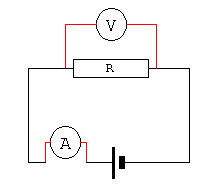|

When current passes
through a resistor,
electrical energy is
converted into heat.
This heat is DISSIPATED
into the surrounding
air.
The rate at which this
dissipation occurs is
called POWER and is
measured in WATTS.
The amount of power can
be calculated by using
one of three methods.
(1) Power = V x I watts
(2) Power = (V x V)/R
watts
(3) power = (I x I)R
watts
Also see the page with
the VIRP wheel.
If we place a 10 ohm
resistor across a 20
volt battery then Ohms
law says that I = V/R =
20/2 =2 amps will flow.
Using (1)
power = 20 x 2 = 40
watts
Using (2)
power = (20 x 20)/10 =
400/10 = 40 watts.
using (3)
power = (2 x 2)x10 = 4 x
10 = 40 watts.
Using three different
formulae we still arrive
at the same answer.
We know that power is
the rate at which energy
is used.
The amount of energy
used is measured in
JOULES.
Joules = watts x
seconds, therefore watts
= joules/seconds.
A 1000 watt fire will
dissipate 1000 joules
per second.
With resistors, the
greater the dissipation
the hotter it gets, and
the larger the resistor
needs to be.
The electric meter in
your house measures
UNITS of electricity.
A unit is when you use
1000 watts for one hour.
This is called 1
Kilowatt hour.
It is kilowatts x hours.
A 100 watt (0.1
kilowatts) lamp left on
for 24 hours uses 0.1 x
24 = 2.4 units.
You or your parents
are charged by the unit.
If a unit cost 5 pence
then the lamp would cost
12 pence a day to run.
Switch it off and help
to save the world. |